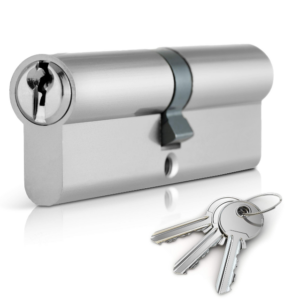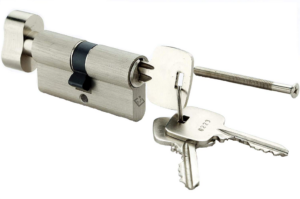Introduction
Welcome to this thorough explanation of euro cylinder locks. You’ve arrived to the right site if you’ve ever been curious about how a euro cylinder lock operates. We shall examine the workings, parts, and mechanisms of euro cylinder locks in this post. This article will give you the knowledge, perceptions, and direction you require, whether you’re a homeowner trying to improve your home security or a locksmith seeking in-depth knowledge.

How Does a Euro Cylinder Lock Work?
Due to its durability and adaptability, the euro cylinder lock is a type of lock that is frequently used in Europe and has acquired appeal all over the world. It is made up of a number of important parts that work together to offer safe access control. Let’s explore the inner workings of a euro cylinder lock step by step.
Cylinder Core
The heart of a euro cylinder lock is the cylinder core. The keyway is contained in a cylindrical housing that communicates with the key. A set of pins and springs that are located inside the cylinder core allow the lock to operate.
Keyway
The channel or groove that runs the length of the cylinder core is known as the keyway. It has been specifically created to accept the lock’s unique key profile. Only the proper key may interact with the pins inside the cylinder thanks to the keyway, which makes it possible to operate the lock.
Pins and Springs
The lock’s functionality depends heavily on the pins and springs inside the cylinder core. Each pin consists of the driver pin and the key pin, and they are stacked together. The key pin is located below the shear line, whereas the driver pin is positioned above it. The tension created by the springs’ downward pressure on the pins prevents the cylinder from freely turning.
Shear Line
The space between the lock’s cylinder core and outer housing is known as the shear line. When the right key is put into the lock, the pins line up at this location. When the key is inserted, it raises the key pins, lines up the shear line, and permits rotation of the cylinder.
Cam
The cam is a protrusion that connects to the back of the cylinder core inside the euro cylinder lock. The cam rotates when the right key is used and turned, causing the lock’s bolt or latch to retract and opening the door.
Advantages of Euro Cylinder Locks
Euro cylinder locks are a common option for residential and commercial applications because they have a number of advantages over other types of locks. Let’s examine a few of these benefits:
Versatility: Without replacing the lock mechanism entirely, Euro cylinder locks can be readily modified or replaced. They are suited for a variety of door types and security requirements because of their flexibility.
Key Control: Homeowners and property managers may easily regulate access to their properties thanks to the greater key control offered by Euro cylinder locks. They can easily restrict key duplication or rekey the lock to increase security.
Security Features: Modern security features found in Euro cylinder locks include anti-pick pins, anti-drill plates, and anti-bump mechanisms. These characteristics make it difficult for burglars to modify or operate the lock.
Compatibility: Widely accessible and simple to install, Euro cylinder locks can be added to existing doors. They work with a variety of locking systems, including mortise locks and multipoint locks.

Frequently Asked Questions (FAQs)
How do I measure a euro cylinder lock?
Take off the door’s current lock. From one end of the cylinder to the other, measure its overall length. Calculate the distance between the lock faceplate’s edge and the cylinder’s center. Make a note of the millimeter measurements.
Can I replace a Euro cylinder lock myself?
If you have the required equipment and a basic understanding of locks, you can replace a euro cylinder lock yourself. To ensure correct installation and compatibility with your door, a professional locksmith is always advised.
Are euro cylinder locks resistant to lock snapping?
The degree to which Euro cylinder locks are resistant to lock snapping varies. Search for euro cylinder locks with anti-snap lines or snap-resistant designs to increase security against this popular break-in method.
Can I use the same key for all euro cylinder locks in my home?
You can use the same key to open numerous euro cylinder locks in your house, thus yes, it is doable. It is referred to as the “keyed alike” or “keyed to pass” system, and a locksmith can rekey the locks to function more conveniently with just one key.
What is a thumb-turn euro cylinder lock?
A variation with a thumb-turn on one side of the lock as opposed to a key is known as a thumb-turn euro cylinder lock. Without a key, it enables quick and simple locking and unlocking from the inside. To prevent unwanted access via the thumb turn, it is crucial to make sure the right security measures are in place.
Can I upgrade my existing euro cylinder lock for better security?
To increase security, you can upgrade your current euro cylinder lock. Be on the lookout for high-security features like anti-pick, anti-drill, and anti-bump ones. Consult a qualified locksmith who can advise you on the finest upgrade possibilities based on your unique needs.

Conclusion
In conclusion, homeowners, property managers, and locksmiths must all grasp how a euro cylinder lock operates. Secure access control is made possible by the complex interaction of the cylinder core, keyway, pins, springs, shear line, and cam, which also adds to the overall security of a building. Euro cylinder locks are a popular option for home and commercial applications because of their adaptability, key management, and improved security features.
Keep in mind to measure euro cylinder locks precisely, think about upgrading to higher-security solutions, and seek out experts as necessary. You may increase the security of your home and feel more at ease by installing strong euro cylinder locks.
